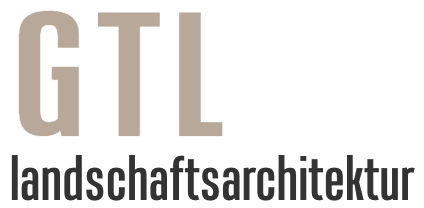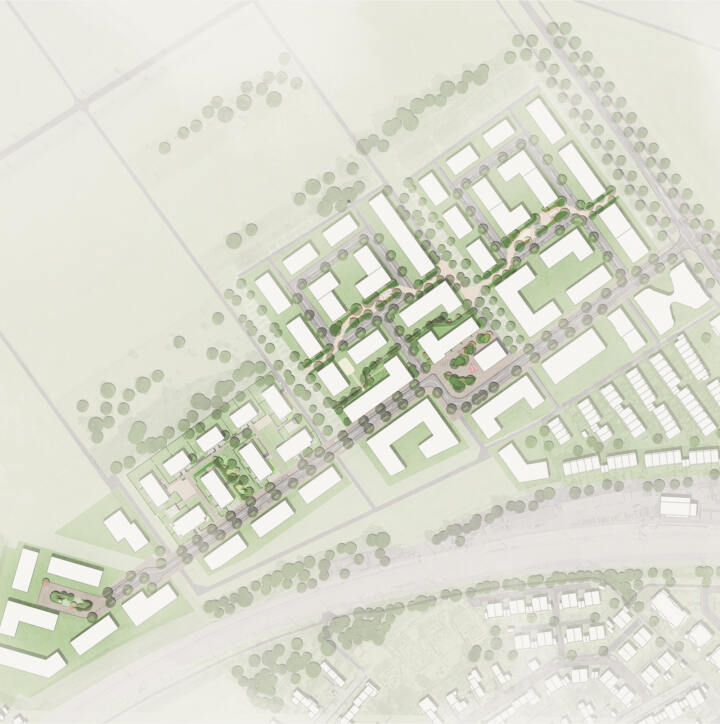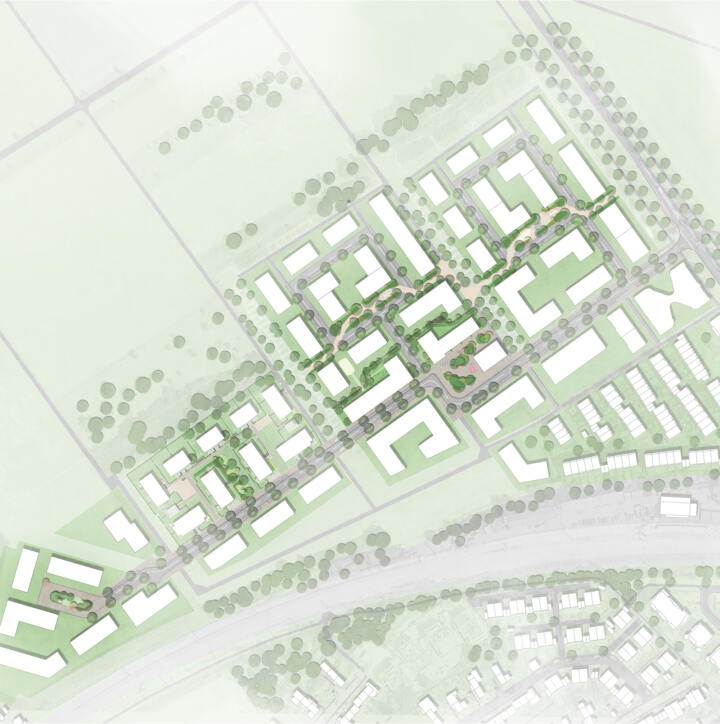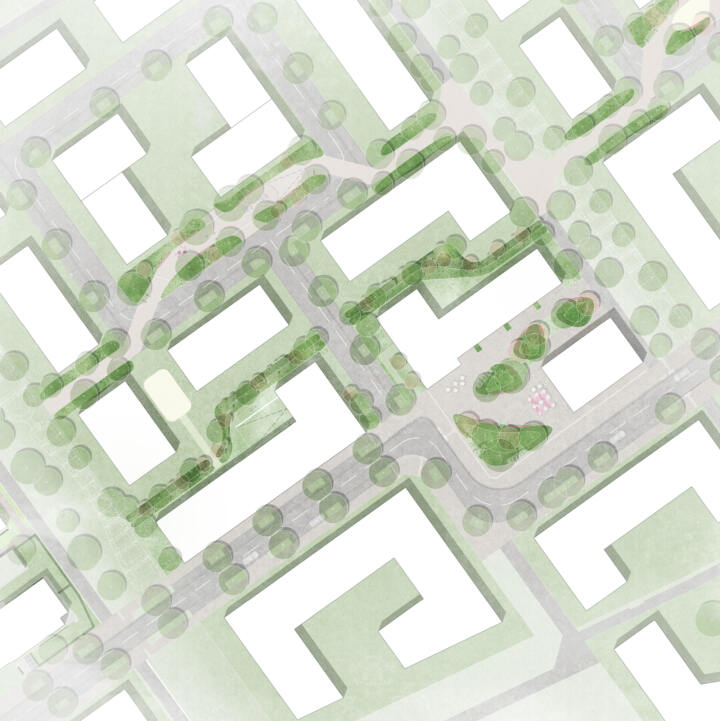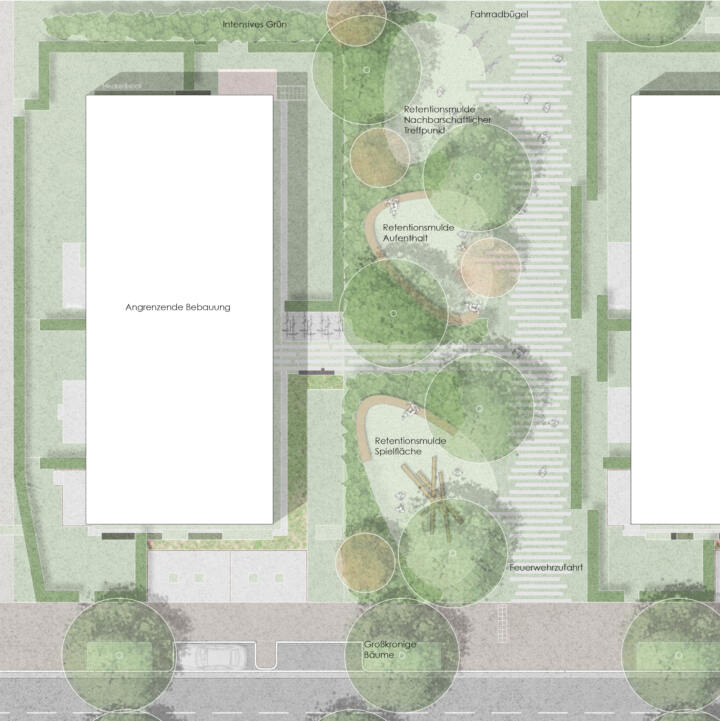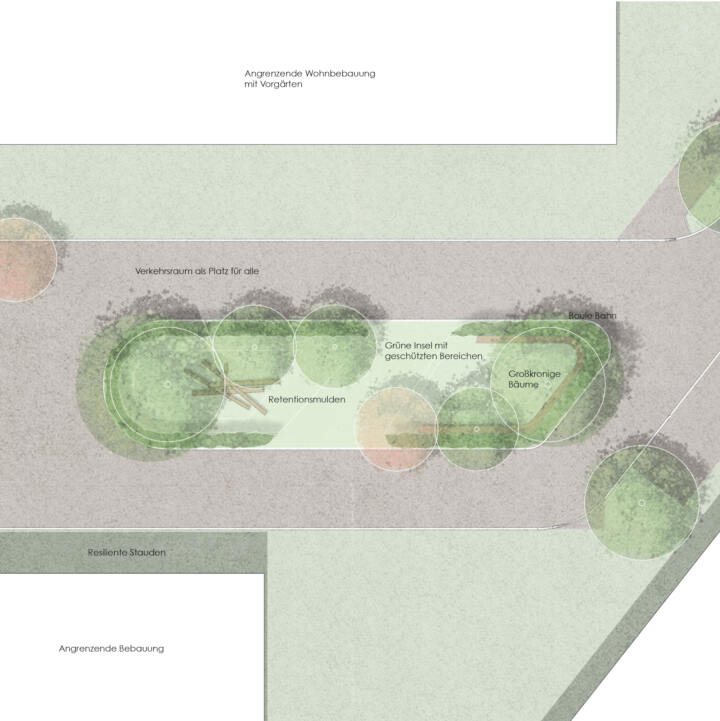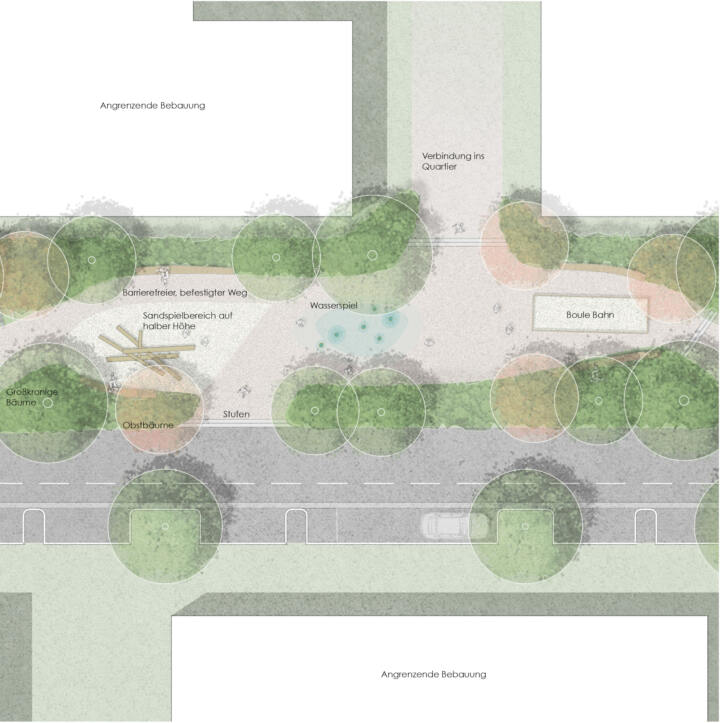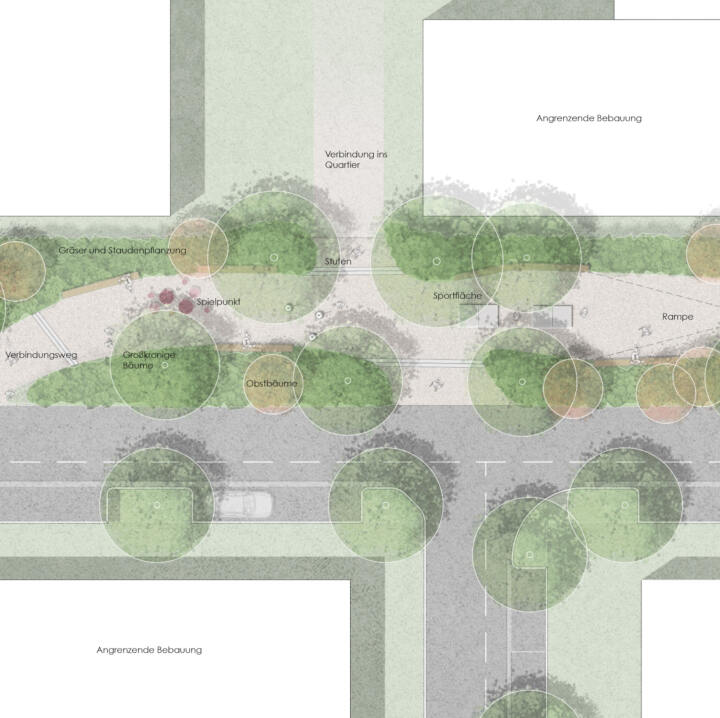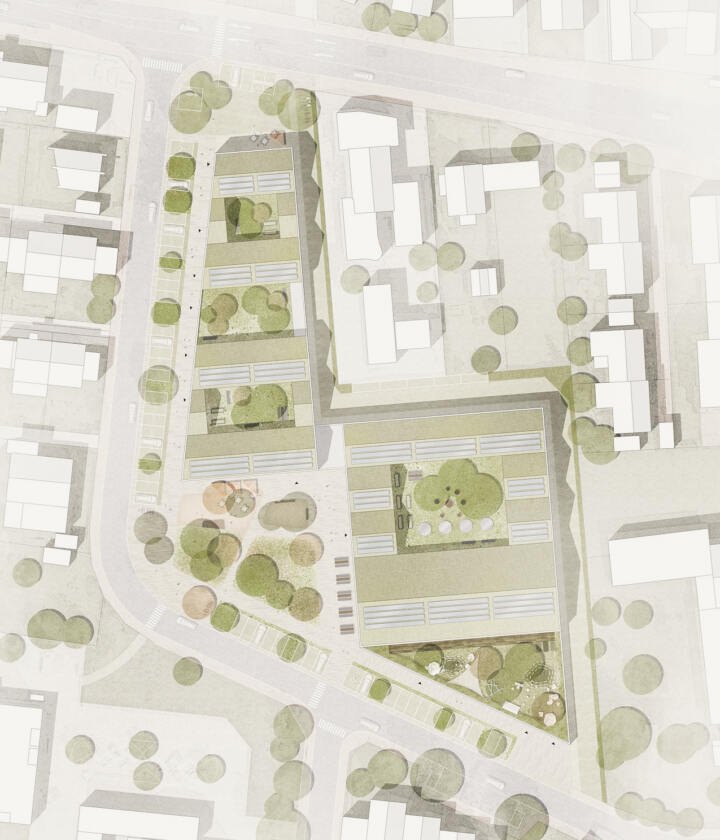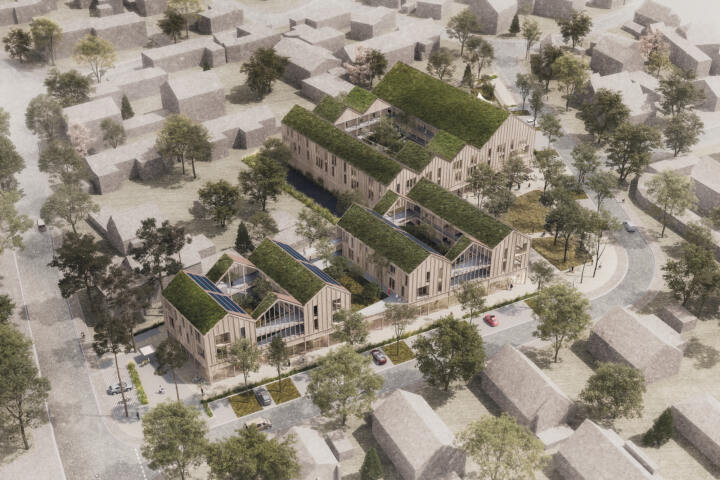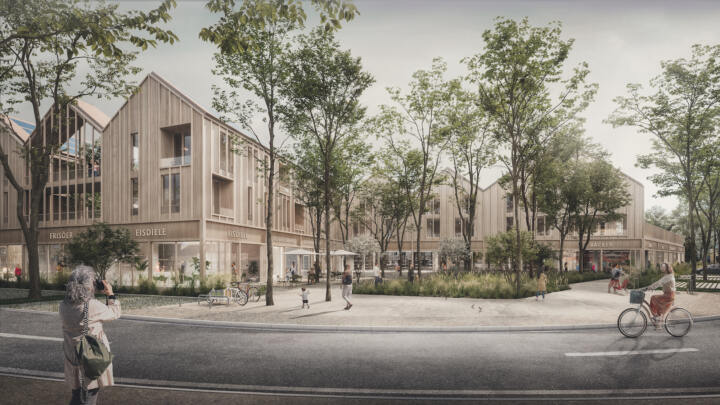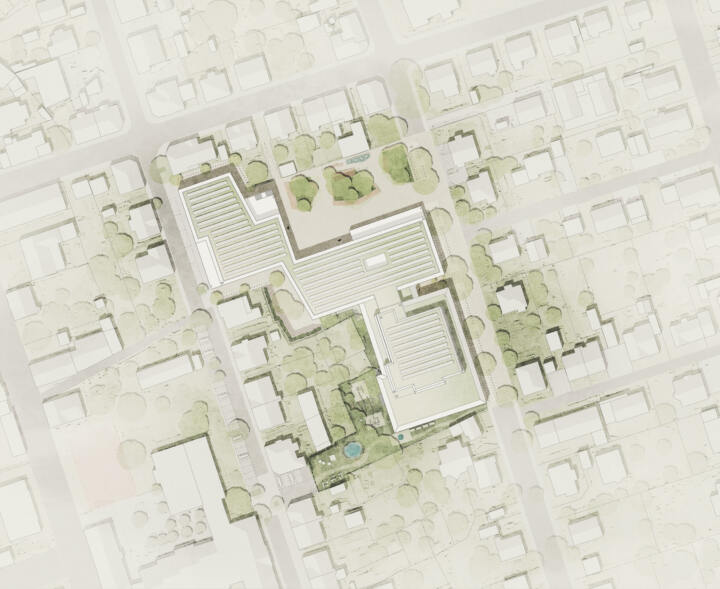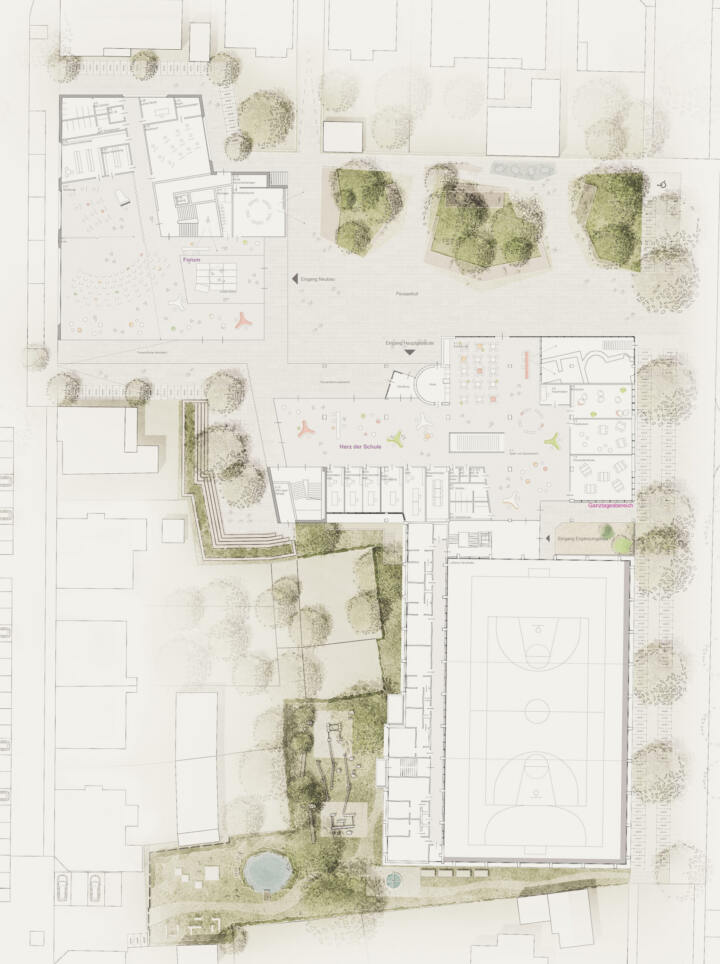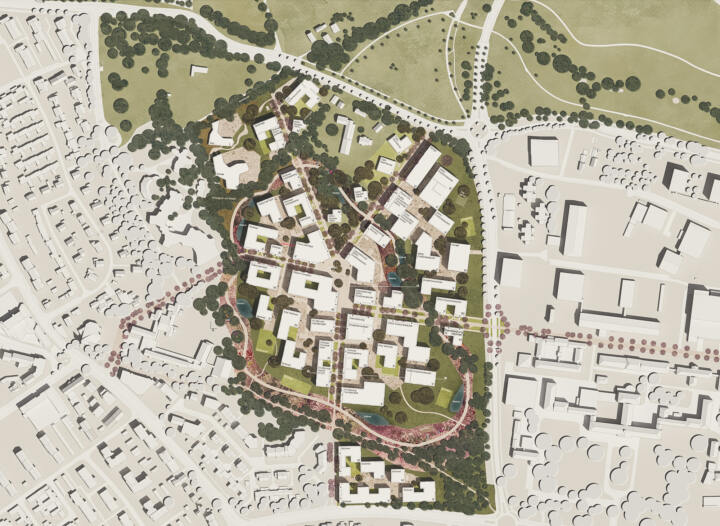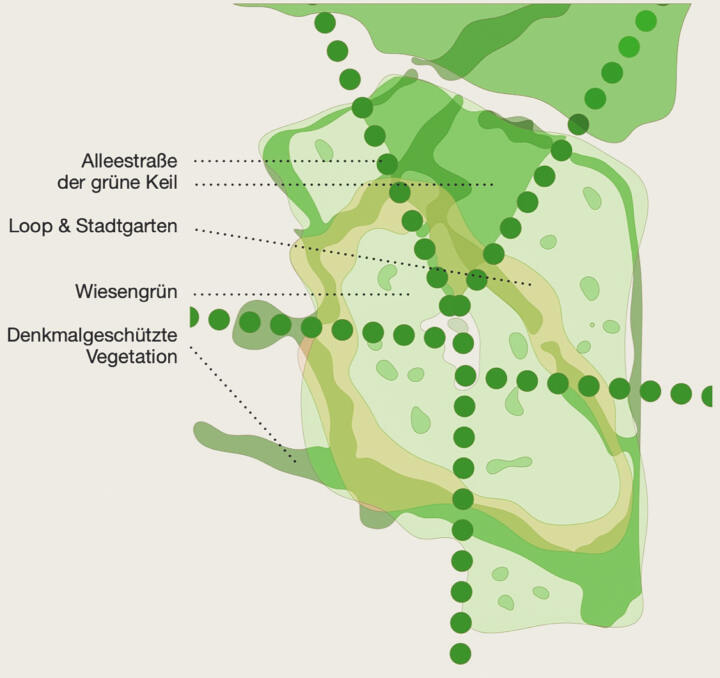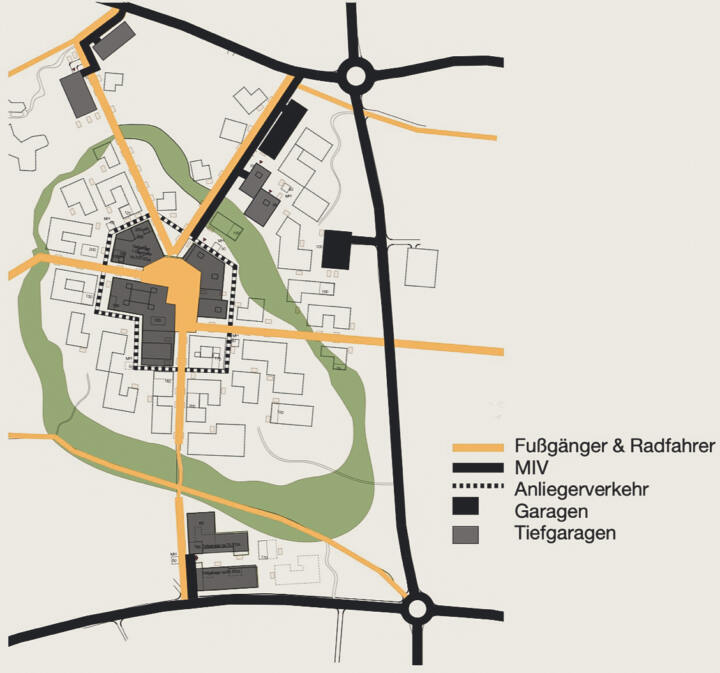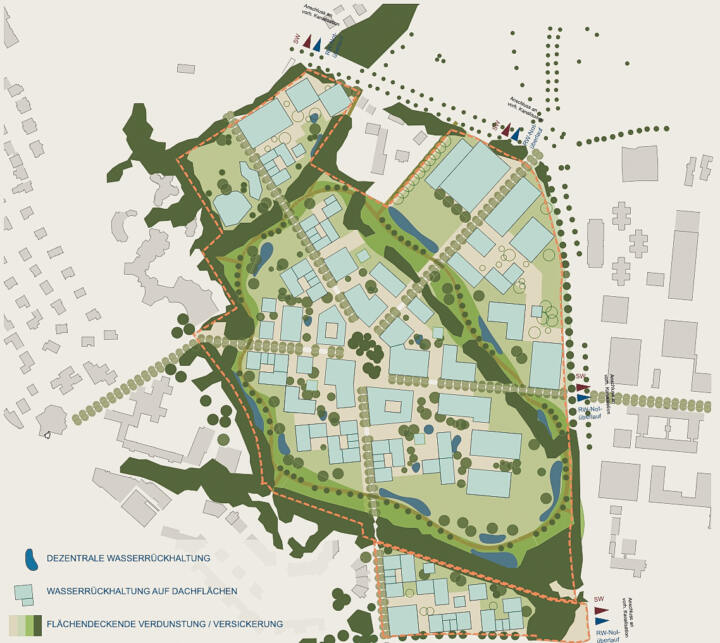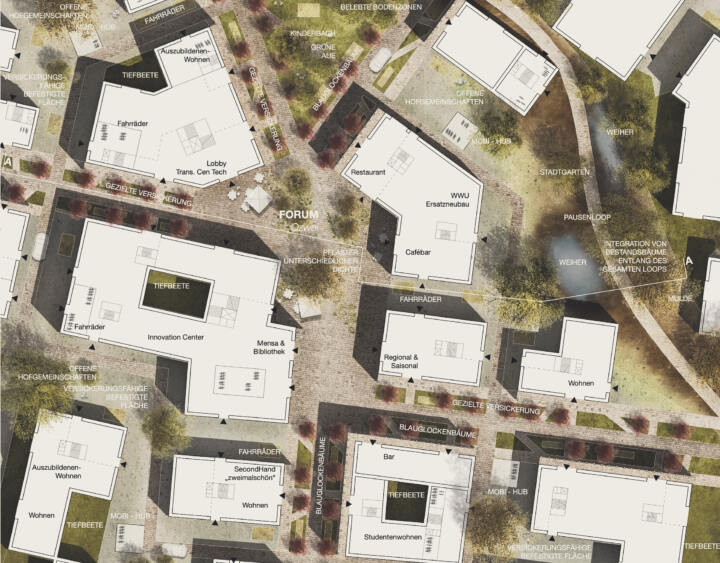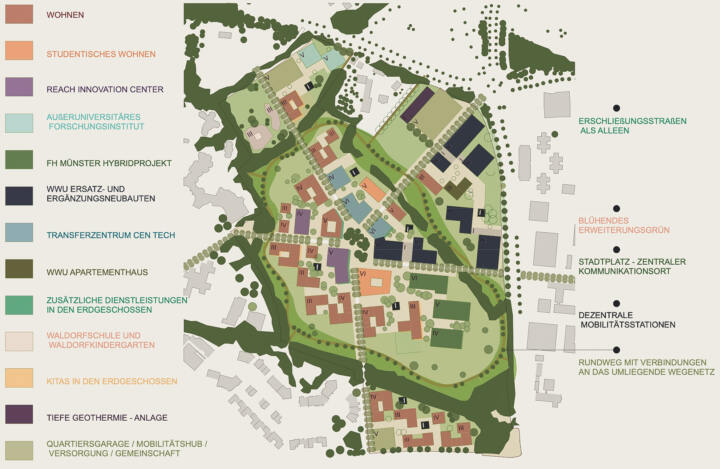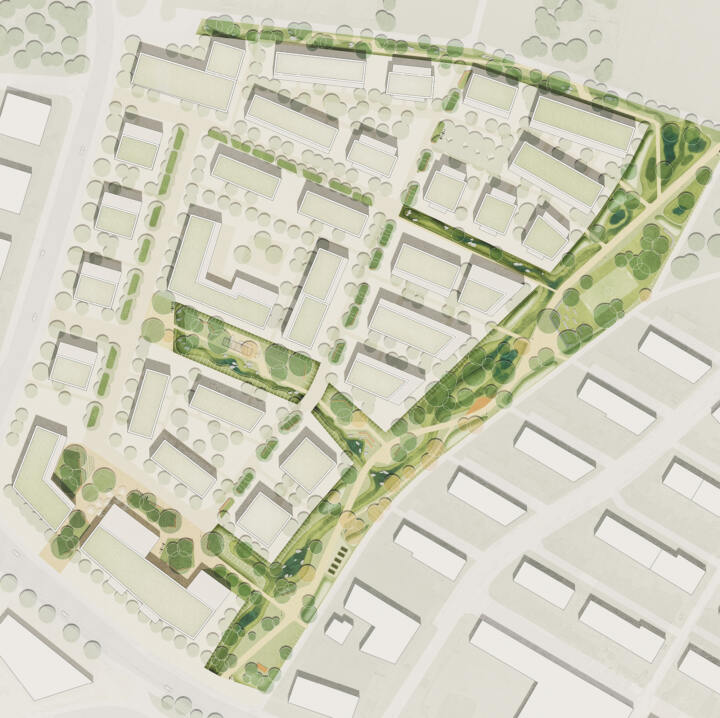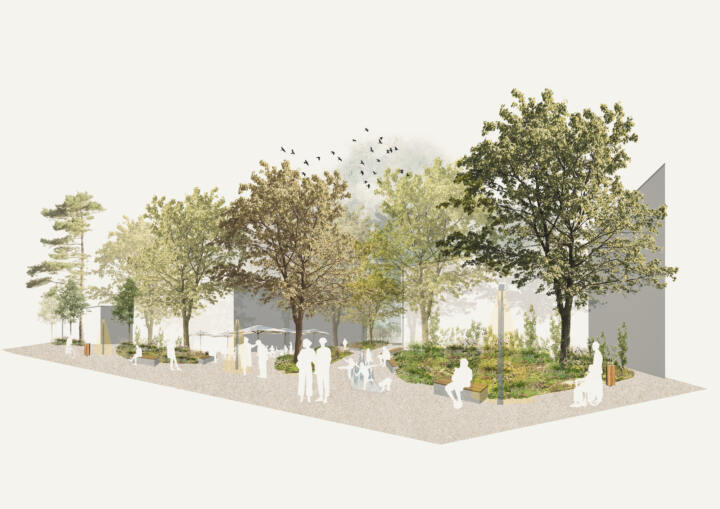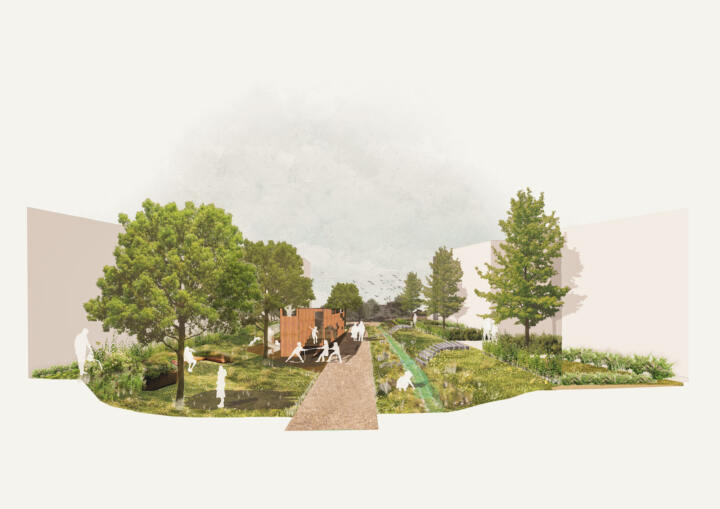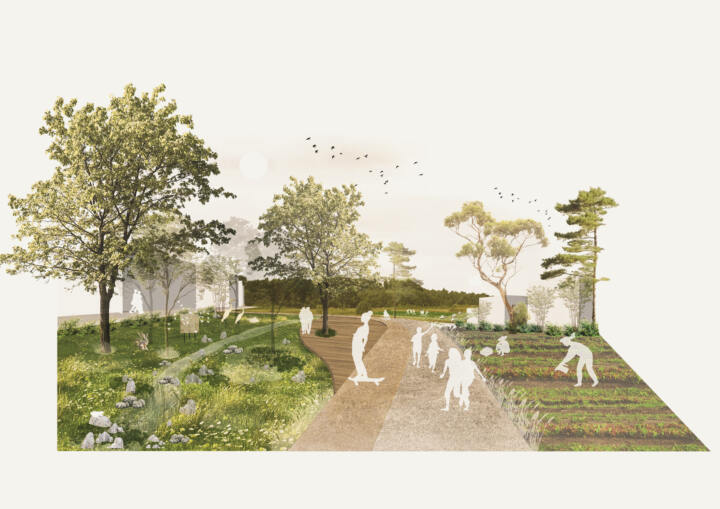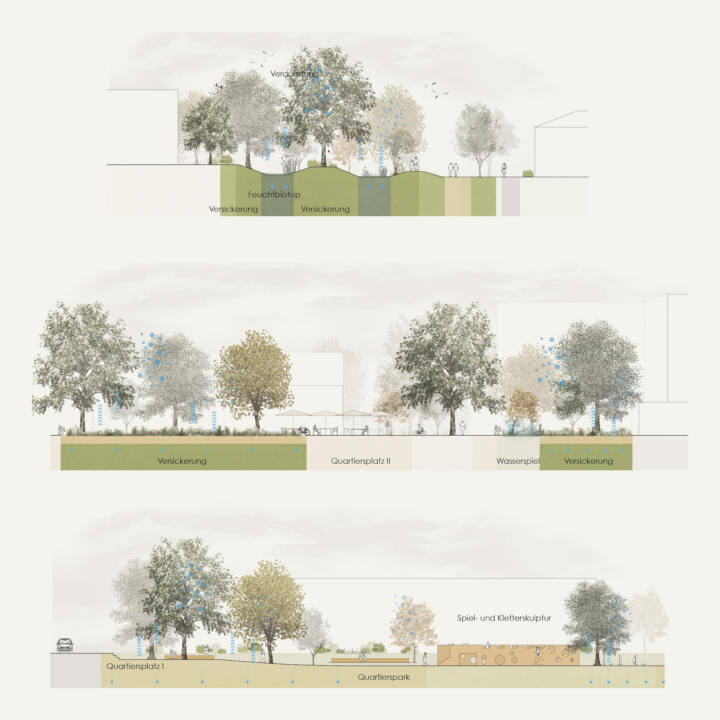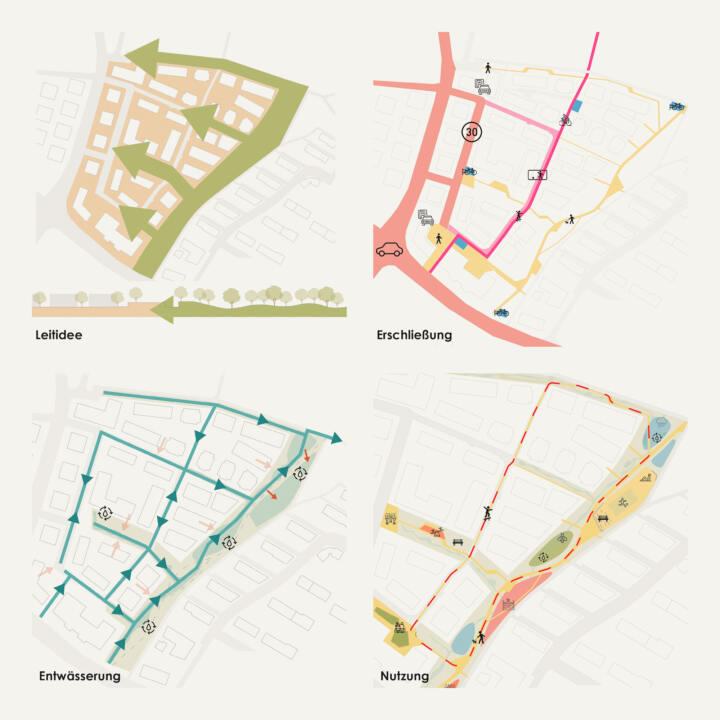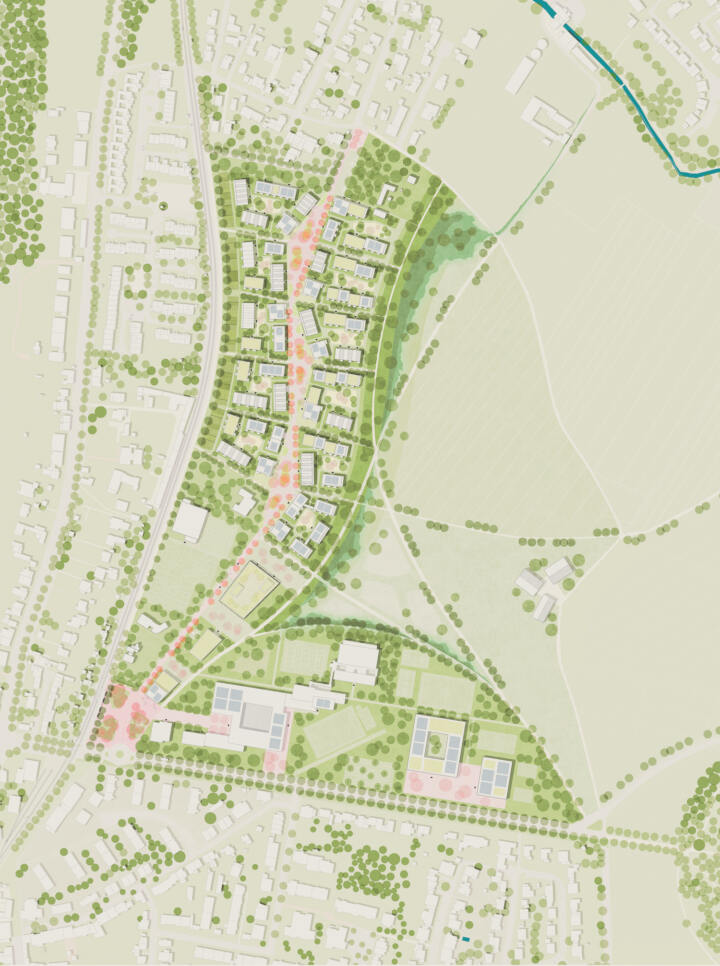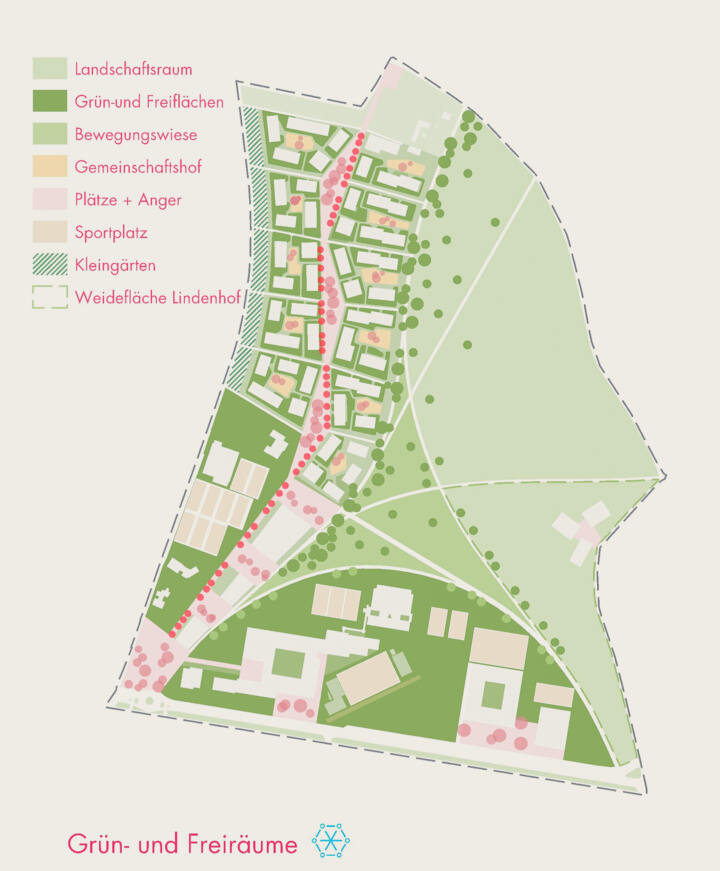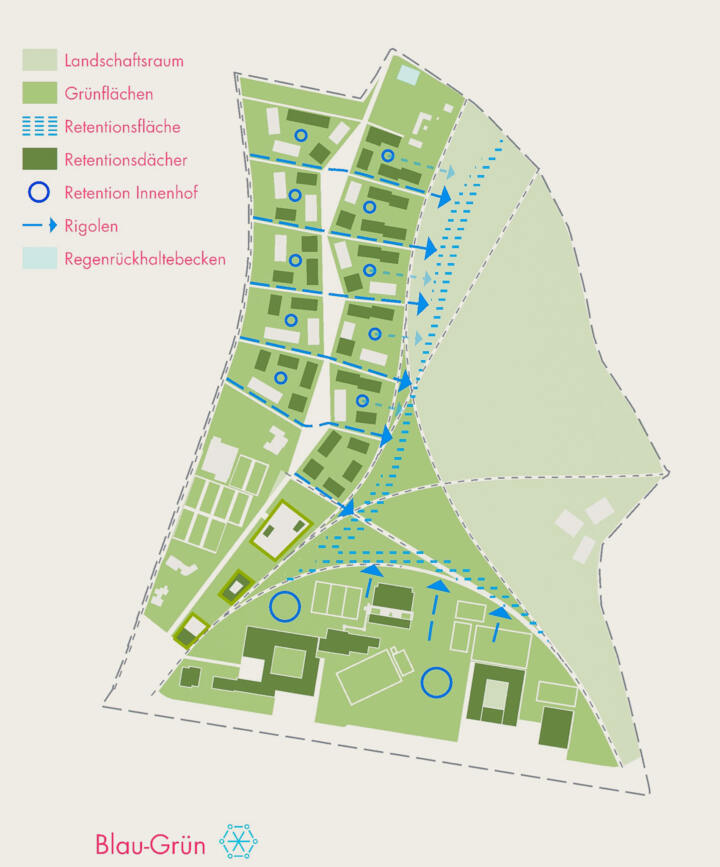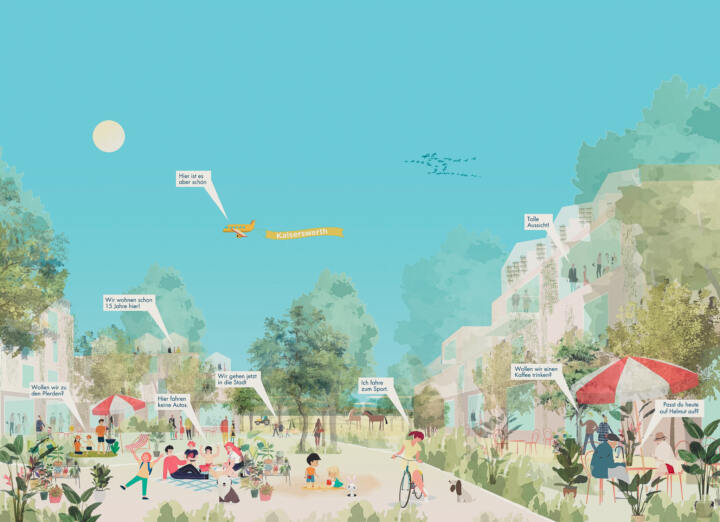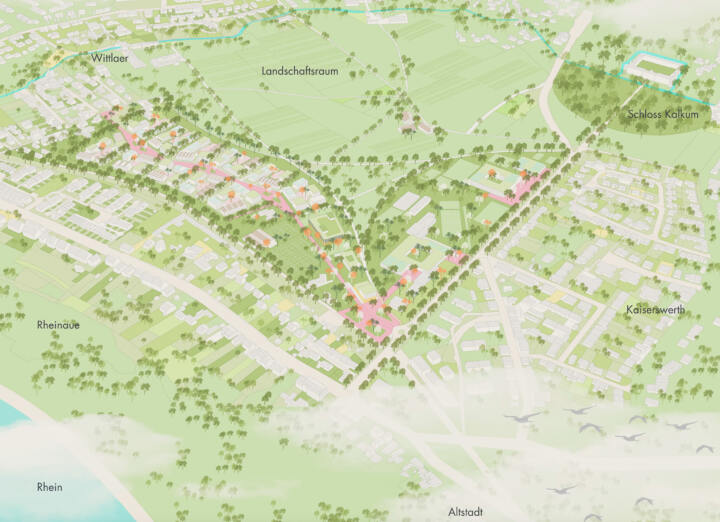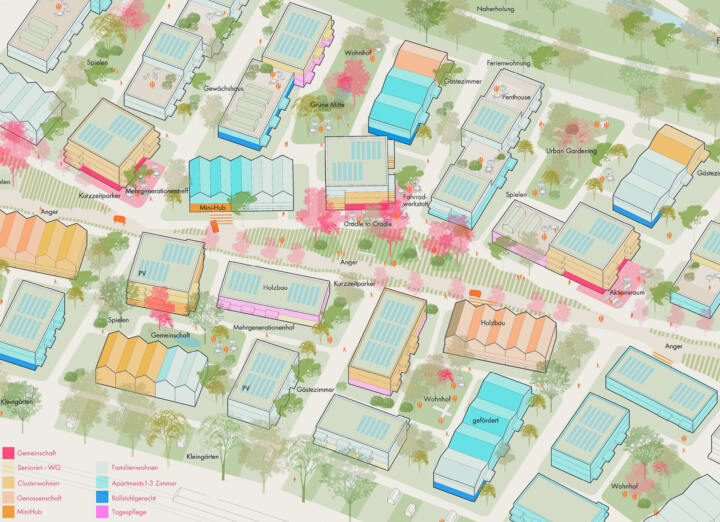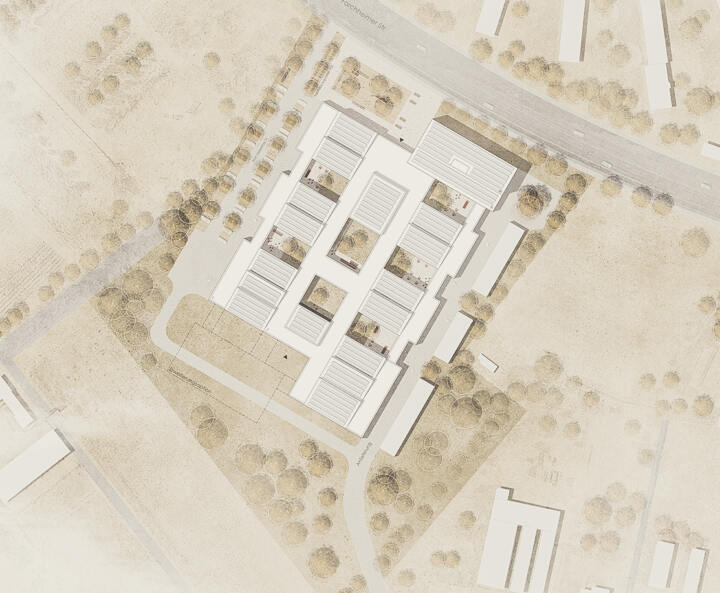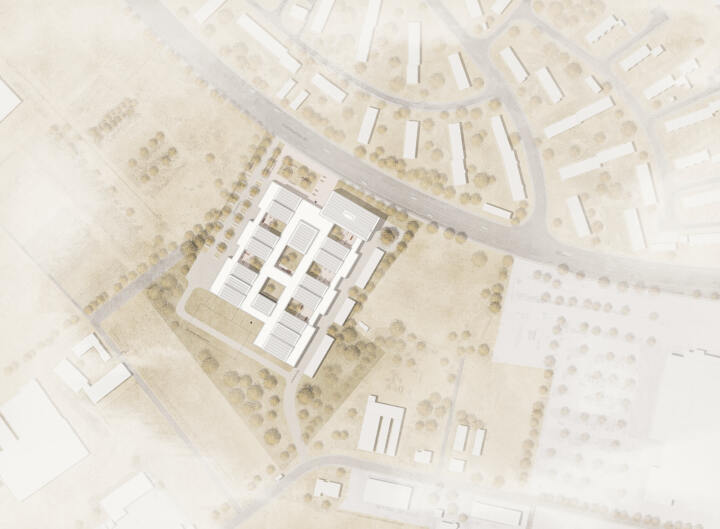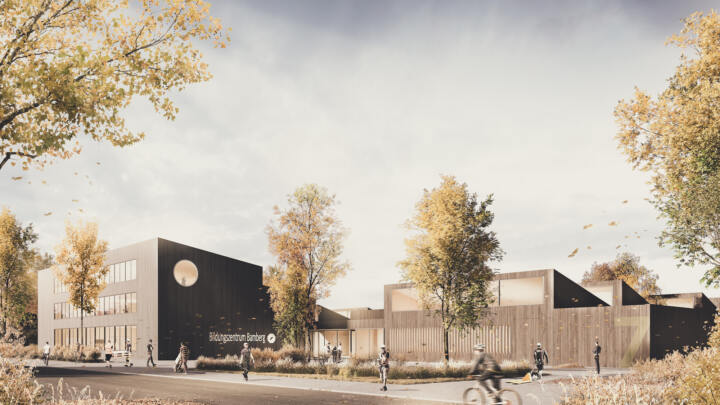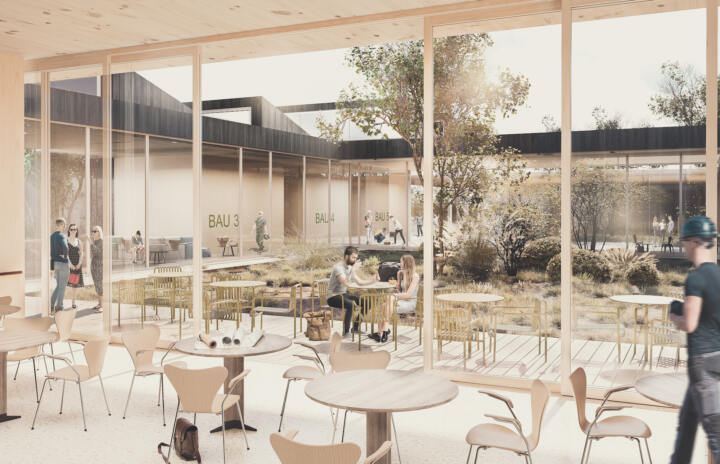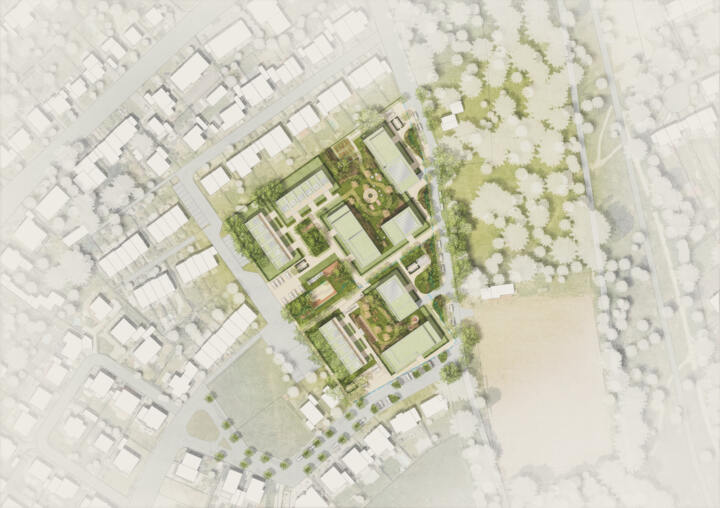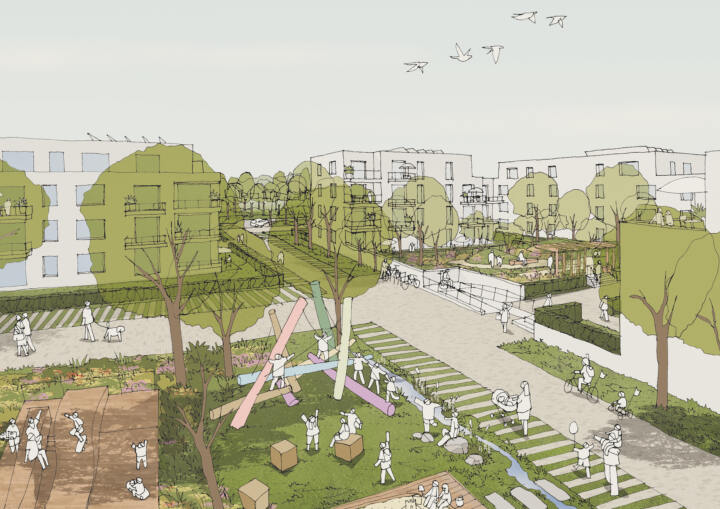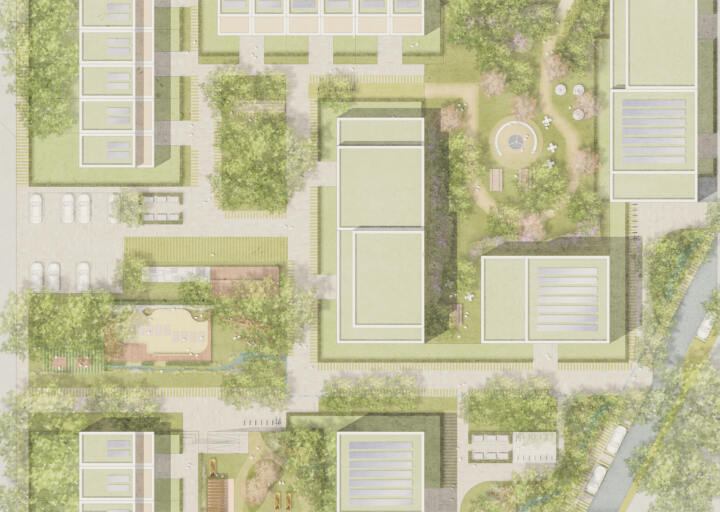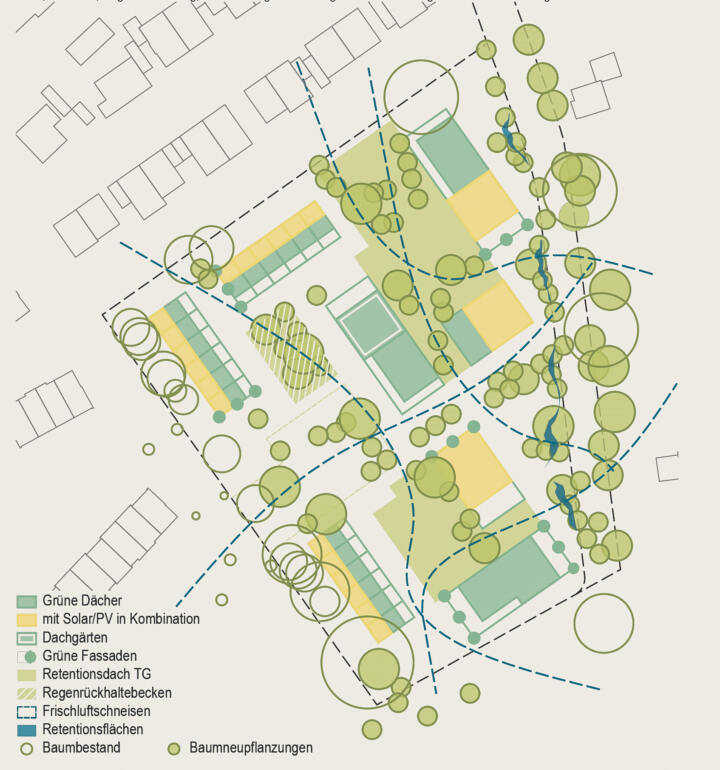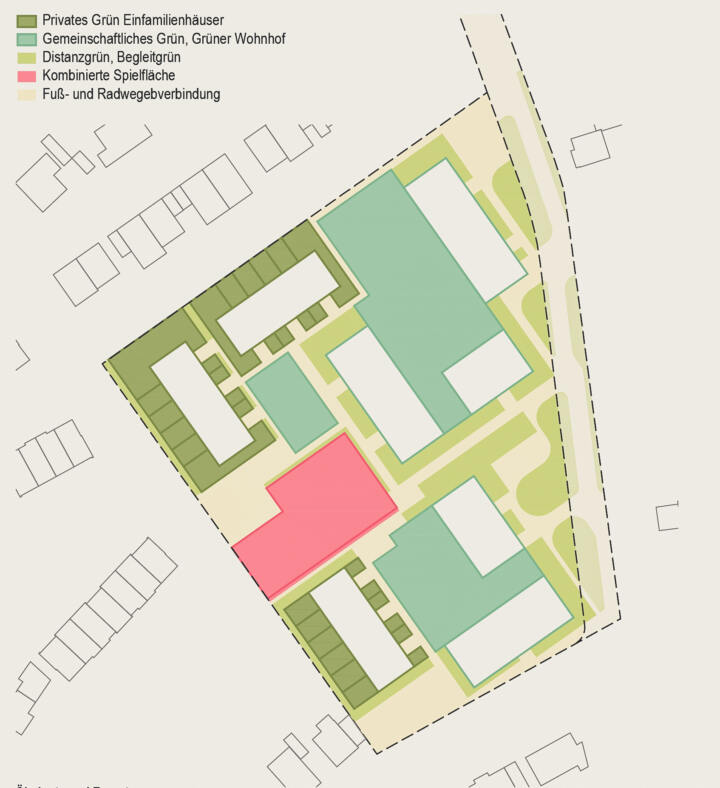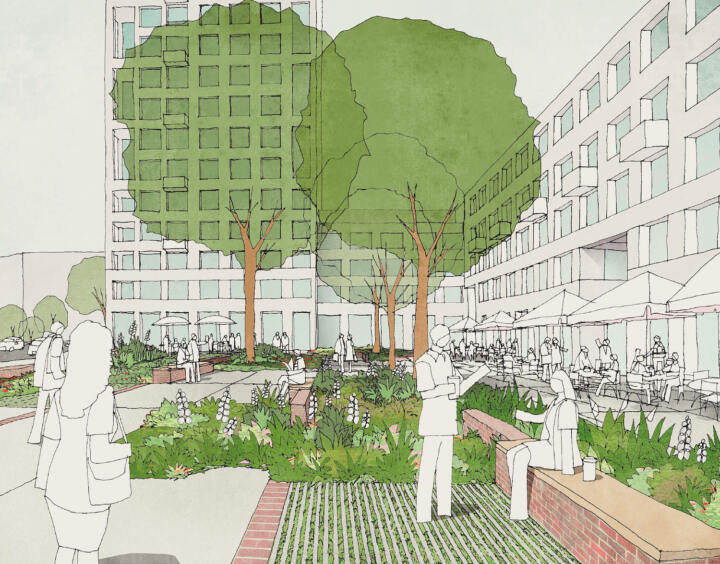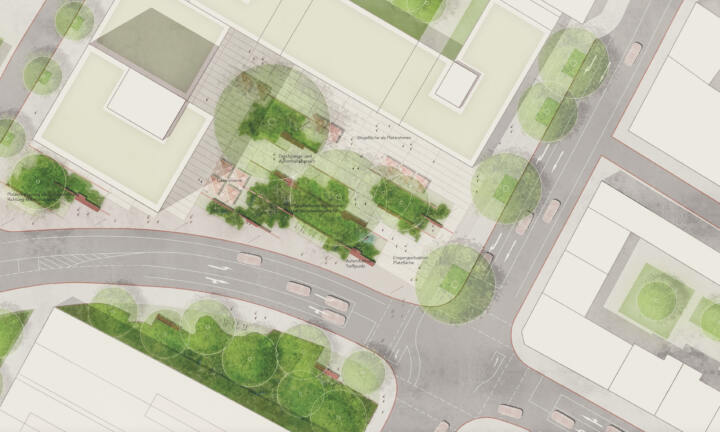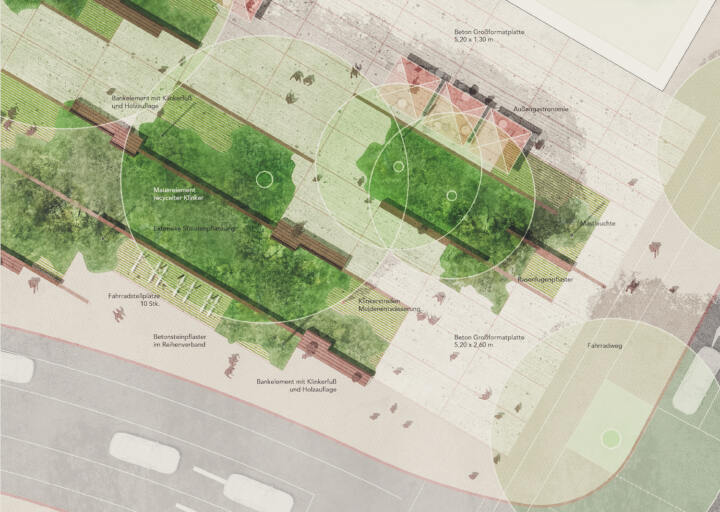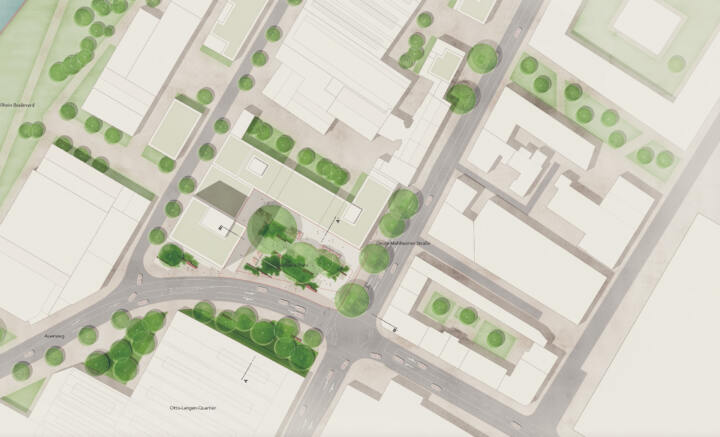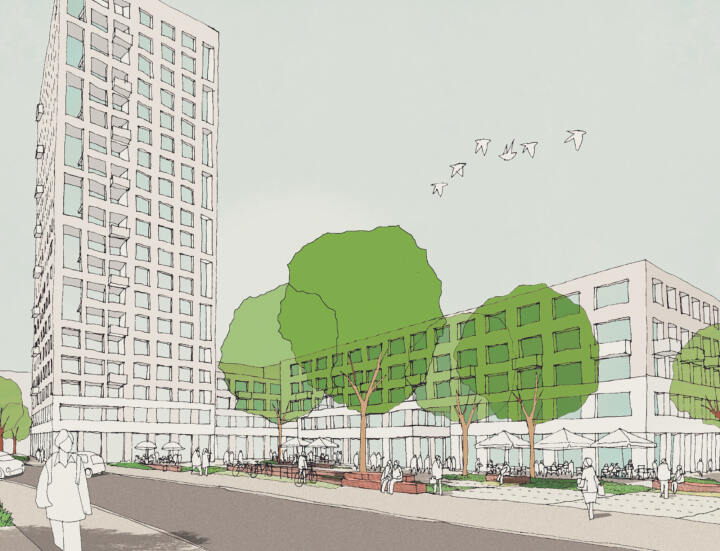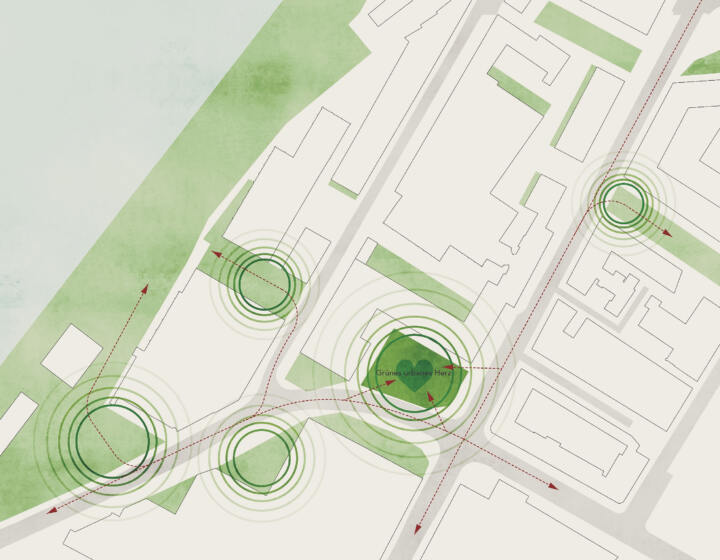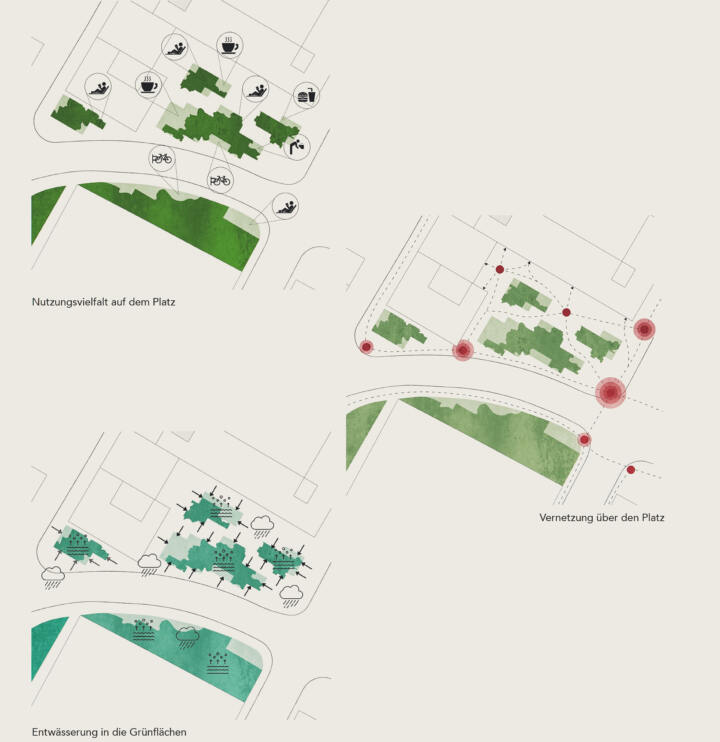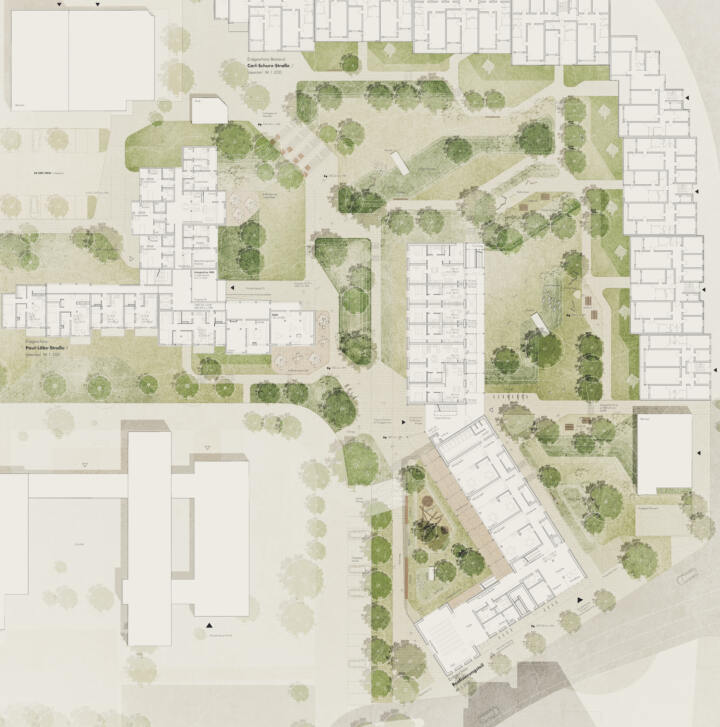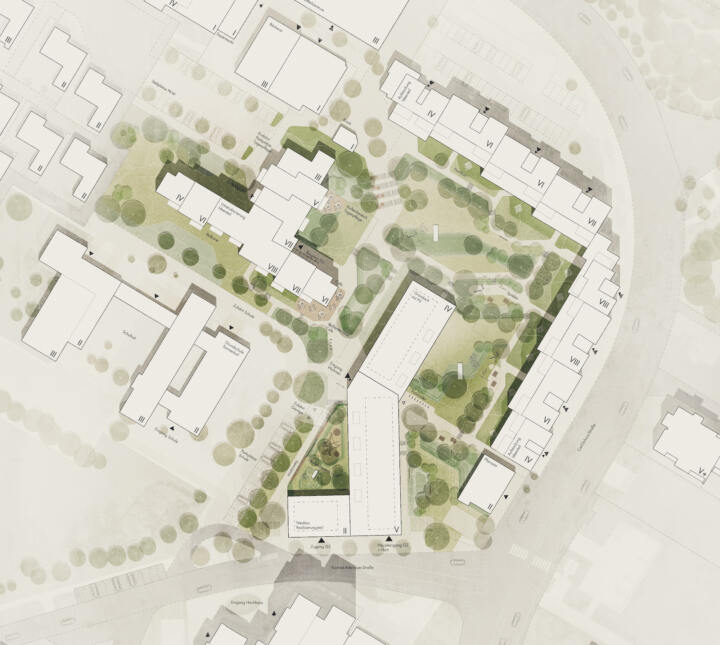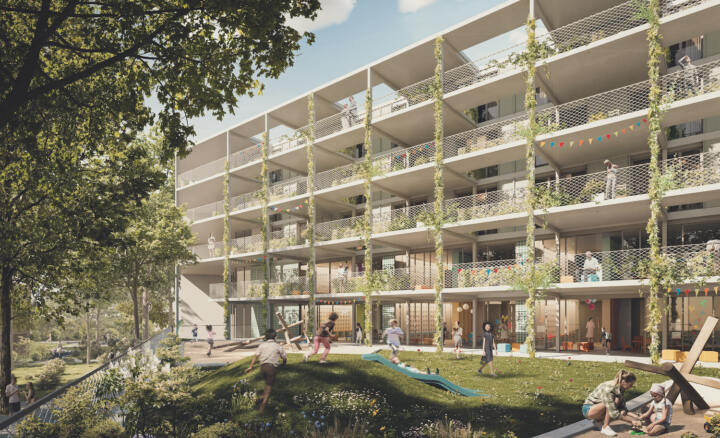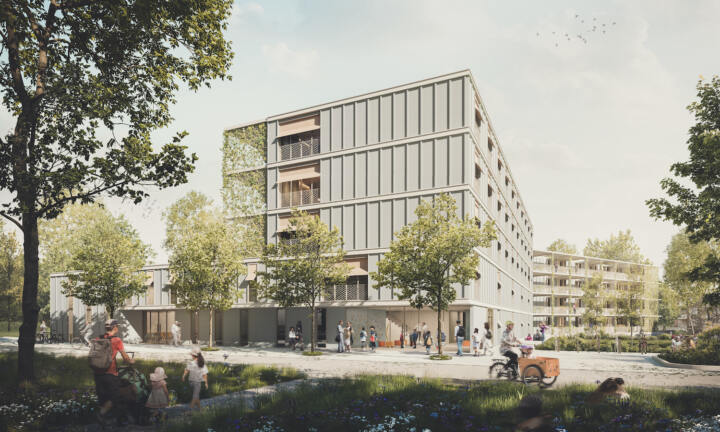Hilgenfeld | Frankfurt
3. Prize | Hilgenfeld
Frankfurt
In collaboration with dirschl.federle architekten
‘Living with green loggias’ is the leitmotif of our design. The green spaces of the Hilgenfeld connect the neighbourhood and integrate the loggias of the flats.
Building B3.2 with commercial and residential units responds to the square in front of it. It forms a head situation at the corner of the square, in which a publicly accessible use with an effect on the square was to be accommodated.
The public open spaces, which are spread across the entire neighbourhood, offer the opportunity to create a green connection between the individual residential areas. This creates an important cross-connection with isolated widenings and squares that increase the proportion of greenery and offer additional recreational areas and meeting points.
Green spaces
Green spaces, in particular areas with trees, have a positive effect.
Fine dust reduction, pollution control, shade and a cooling effect are the measurable values. But spending time under a tree canopy, sitting in a meadow, gardening together, the aesthetic effect, the pleasant odours of flowers and fruit are just as perceptible as they are beneficial.
When selecting trees and shrubs, care should be taken to ensure that they are not sensitive to the changing conditions caused by extreme summer temperatures, periods of drought, heavy rainfall etc. at the site. Open tree discs and the planting of trees and tree trenches underneath lead to a significant reduction in surface runoff, while at the same time increasing infiltration and evaporation values.
Nourishing shrubs and nesting and breeding opportunities are provided for “green diversity” within the planting areas. When selecting the trees and shrubs, climatic trees will be excluded. Special trees such as the hop hornbeam and the bluebell tree are planted in the squares. In this way, the areas differ from one another and always offer different highlights throughout the year. The flowering and fruiting of the trees is also taken into account in order to provide food for insects and birds. The habitus of the trees is chosen so that they create a large shaded area, especially in the traffic areas.
Rainwater
In the spirit of the sponge city concept, the aim is to keep as much rainwater as possible on site, allow it to seep away and/or evaporate and thus positively change the climate in the neighbourhood in the long term. Where possible, rainwater is therefore drained away via the green spaces. In addition, the lowered square areas provide retention volume for heavy rainfall events. Only excess water is released into infiltration channels. The increased number of trees planted is a key factor. The trees provide shade in the summer months and thus sustainably reduce heating, they absorb rainwater and release some of it again through evaporation.
Spaces and uses
With their elongated shape, the two squares P 2 and P 3 form the southern end of two sub-areas in the new neighbourhood. These public communal areas are intended to be understood and used as green transitional and connecting spaces: direct access from the neighbouring areas to the north means that neighbourly life and play are offered here in the immediate vicinity of the living space, and these green spaces also connect the sections of the neighbourhood with each other in an east-west direction. The lush green setting creates a protected space that nevertheless remains open and inviting. Accessible via ramps and steps, the recessed areas offer space for play and sports as well as various places to spend time. Due to its slightly lowered position, the square is an important component of the rainwater concept. In the event of heavy rainfall, the rainwater can be temporarily stored so that it can then evaporate and seep away over unsealed surfaces. Squares P 4 and P 5 will be designed in the same way. Here, too, intensively planted areas will be created with play and recreational facilities. In area P 4, the paved area for the fire brigade will be reduced to the essentials; necessary traffic areas and planted areas will interlock and form soft transitions.
The neighbourhood is invited to meet here on the long benches in the shade under the trees. The small square P 5 forms an island within the necessary turning loop. As very little traffic is expected here, the entire street space can be designed as a square. The inner area forms the green centre. Hedges create a retreat here and large trees provide the necessary shade for the paved areas. Retention areas are also generated here
Rainwater is collected in the recessed areas of the squares and seeps away or evaporates. Integrated or neighbouring plants are selected with a view to tolerating longer dry periods and temporary water accumulation.
Cornflower Square forms the heart of the neighbourhood. Commercial areas and cafés are located here, giving the square a special significance as a place to spend time. The central idea of bringing plenty of greenery into the neighbourhood is also continued here. The green spaces extend across the square and at the same time form a frame towards the street. The areas planted intensively with shrubs and grasses are supplemented by infiltration troughs at the edges. The centre of the square is deliberately kept open to provide space for events such as flea markets. Small drinking fountains offer the opportunity for refreshment and play. 2 cafés line the edges of the square.
Local Supply | Göttingen
2. Prize | Local Supply
Göttingen
In collaboration with pape+pape architekten
The open space concept of the new local shopping centre is defined by generous open and green spaces, which lead to a transformation of the place in which the car is no longer in the foreground.
The spatially sophisticated building design integrates further green spaces into the building itself. The inner courtyards on the first floor take numerous other opportunities out of the buildings to make the centre even greener.
The forecourt opens up the local shopping centre to the neighbourhood and develops into a public square for everyone. The significant reduction in paved areas allows water to seep away more easily and fits in with the sponge city concept.
The preservation of the existing trees and the planting of additional deciduous trees and fruit trees are particularly important for this, but the use of grass paving for the car parks also contributes to this. The remaining paved areas will be fitted with light-coloured concrete block paving.
Numerous seating and recreational areas will also be integrated, which can be found at the café in the north or at the neighbourhood square.
The roof garden and inner courtyards also create a special place to relax and meet with seating and vegetation.
In addition to car parking spaces, particular emphasis is placed on a large number of bicycle parking spaces. Bicycles can be parked at various locations; cargo bikes and e-bikes of all kinds can also be charged and parked, making the local shopping centre modern and inviting. This is supported by parking spaces for car sharing, micro and light vehicles and areas for mixed use.
The daycare centre’s raised garden, which is located on the first floor and protected by wide shrubbery, is particularly noteworthy. In addition to play hills and play elements, there are also other deciduous and fruit trees here, which, in combination with beds in the raised garden and inner courtyard, invite children to plant and eat their own food.
Eugen-Bolz-Secondary School | Rottenburg
Recognition | Eugen-Bolz-Secondary School
Rottenburg
In collaboration with Atelier 30
The existing school area is implemented in a structurally heterogeneous environment.
The new heart of the school landscape is located in the forum of the new building. The central space, which includes a gallery, offers many possibilities for use by the school community.
The future traffic development consists of a successful mix of motorised private and public transport, as well as cycling and pedestrian traffic. With the exception of a few barrier-free parking spaces, cars are parked outside the school area and the existing school grounds are implemented in a structurally heterogeneous environment.
The urban positioning of the buildings on Eberhardstrasse is orientated towards the important footpath connection in the direction of the public transport stops, and opens up the schoolyard in a meaningful way, which, as in the existing building, connects to the footpath in the direction of Sophienstrasse in the north (barrier-free access via a ramp) and opens up towards Mechthildstrasse.
The sections of the open spaces correspond closely to the new school building. The forecourt, which opens onto the street, leads directly into the “heart” of the school campus, the central courtyard between the old and new buildings. The fact that a large part of the courtyard is underpinned by a bunker requires raised planting beds for the necessary tree planting. Chill and learning decks alternating with seating steps turn the resulting raised beds into meeting places during breaks and free periods. The cubature of the raised beds is orientated towards the building structures and creates flowing, semi-open spaces that allow individual occupation of the courtyard while maintaining the necessary clarity. A partially covered area for learning and working at group tables and benches is provided in the northern part of the courtyard, somewhat separated from the break area.
The large playground offers sufficient space for exercise, especially for the younger age groups. The existing exercise facilities to the west of the gymnasium will be supplemented by additional facilities such as calisthenics equipment and parcours elements.
In addition to the requirements of the exercise and learning landscape, the open spaces also fulfil fundamental functions of resilient and sustainable area development. These include a maximum of structurally rich vegetation areas, water-permeable surface paving and rainwater management as a circulation system. All roof surfaces of the school buildings are intensively greened – an approx. 20-30 cm thick layer of substrate stores the rainwater and makes it available to the plants. Where possible, rainwater from the paved areas is channelled into the drainage and storage layer of the raised tree beds and also collected in cisterns for the use of service water.
Busso-Peus Street | Münster
Recognition | Busso-Peus Street
Münster
Concept ❘ A centre, a network full of character, a ring path and the existing, extended vegetation form the basis of the concept for Münster Model Quarter 2. This “nature hybrid” is intended to be an international demonstration project for how sustainable housing and university construction can be combined with intensive reforestation, increased biodiversity and circular resource thinking in a suburban and peri-urban area. Dense and socially networked neighbourhoods are created. What is important is an urban structure in the centre that provokes education, exchange and community and expands along the “avenues”.
The urban-natural landscape ❘ The city and the university merge into a dense sub-centre. The existing vegetation becomes the starting point for a park – for an urban-natural landscape. The urban development project is intended to become a laboratory for the development of a close symbiosis of living and working environments in areas close to the city and help the city of Münster to realise its ambitious nature and climate protection goals. The overlapping of uses will enable a new urbanity on the outskirts of the city. A centre and structural density, consistent networking with the surroundings, the strong framework of tree structures and a mule track through the intensive natural garden are the basis of our concept for Model Quarter 2 in Münster.
Open space concept ❘ A central square forms the heart of the new neighbourhood – a forum. This is where the opportunities for exchange, learning and research are concentrated. Open courtyard communities that form around the central square merge into the landscape. Their informal design allows for diverse appropriation and is characterised by the “open” green surfaces.
The neighbourhood is also surrounded by an open landscape area with meadows for play and sport and additional space for animal enclosures and the learning garden.
A flowering perennial field with a walking path and jogging track surrounds the Allende. This serves as a break and after-work diversion and connects the individual courtyard communities.
Existing rows of trees of the natural monuments remain untouched, are supplemented and form a spatial setting. The Appelbreistiege will be crossed carefully and with narrow bridges over the existing ditches. This crossing is kept to a minimum and is designated exclusively for pedestrians and cyclists.
The green corridor along the Kinderbach stream in the north of the site will be brought right up to the central square of the new neighbourhood. This will provide the existing courtyard complex and even smaller individual buildings in the neighbourhood with a lush green environment.
Path and traffic concept ❘ Star-shaped avenues open up the site. They connect to the existing network of paths and meet in the centre of the site. They connect the new district with neighbouring areas such as the research campus, Münster’s city centre and the centre of Gievenbeck. The most important connection is the route from the city centre via the research campus to the centre of the new quarter. The junction with Busso-Peus-Straße is emphasised by a circle of trees and the new buildings on the west side form a gateway to the new quarter. Of the total of five access roads, four are intended exclusively for pedestrians and cyclists. Each street is lined with green spaces and framed by the buildings.
Coming from the north, from Gievenbecker Weg, motorised traffic will be routed to the central square under the underground car park. Delivery, emergency and refuse vehicles can drive through the neighbourhood on a ring road. The courtyard communities can be delivered via the gravelled lawn areas.
Drainage concept ❘ The design follows the principle of the “sponge city” with the components of evaporation, storage and infiltration of rainwater. If the surface materials allow a low level of evaporation or infiltration, the rainwater that accumulates on the open spaces is channelled to troughs and deep beds via suitably designed open ditches or via cross-slopes created on the paths and squares. These are designed for a high evaporation capacity through appropriate planting, in some cases with trees, and are designed in such a way that they also improve the quality of stay and the microclimate.
In addition, retention areas are used for the temporary storage of rainwater for delayed reuse. Part of this is utilised for water storage and groundwater recharge via infiltration trench systems, tree-riogole systems and additional underground systems.
Brunnenquartier | Karben
Recognition | Brunnenquartier
Karben
Open space concept ❘ The Brunnenquartier in Karben will be a future-oriented residential neighbourhood characterised by its blue-green infrastructure. One key component is the green corridor, with areas of park to the north and east. This interconnects with the neighbourhood in the form of green fingers of varying widths and lengths, and so offers an open space of enhanced quality and easy accessibility. For the neighbourhood itself, in terms of its proximity to Frankfurt and a direct connection to rail transport, there is great potential for development.
Neighbourhood squares and green corridors I The green corridors both frame and run through the neighbourhood, with curved paths linking up the key locations in a natural way. The paths are flanked by similarly curved retention basins that widen several times along the way to form wetlands. The concept envisages that not only the rainwater that accumulates in the park is collected, seeps away and evaporates here, but rainwater from all the surrounding residential neighbourhoods too. This will create watercourses and extensive areas of water after heavy rainfall, which, in addition to being ecologically beneficial, will also encourage visitors to play and linger. During periods of normal rainfall, only a few puddles form within these troughs; during longer periods of drought, they lack water altogether, resulting in a constant flux from wet to dry hollows. The selection of resilient plants emphasises precisely these characteristics. Even in dry hollows, the planting also indicates the presence of moist areas. In addition to these deliberately shaped depressions, other areas, such as those devoted to sports, are slightly deepened, so they too can function as retention areas in the event of heavy rainfall. While the green corridors are designed to be more open and flexible in their use, the central park area will become a heavily used neighbourhood park. There are numerous opportunities for getting together here. These include, close to the proposed child day-care centre, a large playground with equipment and a climbing frame made of certified, durable wood.
Neighbourhood squares ❘ The first section of the neighbourhood park is formed by a small neighbourhood square to the west, which serves as a meeting spot. Here, large trees provide shade and benches offer places to sit down and relax. Bicycle racks are located on the perimeter. The entire square consists of a barrier-free water-permeable path that links directly into the paths through the green corridors. The southern square is a lively outdoor area where shops and cafés are located, inviting people to linger on the square. Here too, generous planted areas provide areas where rainwater can collect, seep away and evaporate. Paved areas are to be minimised in favour of creating large green spaces. Trees in the green landscaped areas also serve to shade the paved areas and prevent them from heating up in summer, creating a pleasant microclimate.
Materials and planting ❘ In selecting materials, emphasis has been placed on the responsible use of resources. Great importance is attached to ensuring short supply routes, using local materials and CO2-neutral forms of production. The amount of paved areas is deliberately kept to a minimum. Curved paths through the park have a water-permeable surface, whereby the top layer is strewn with a local gravel mix. The generously dimensioned path through the park will be divided into two areas. A barrier-free 1.5-metre-wide strip will be paved and offer a circular path to serve the needs of skaters, bobby cars and scooters for example. The remaining strip of 2.5 metres will be resurfaced as a water-permeable path. The park’s planting scheme will be intentionally varied, with more intensively planted areas alternating with open lawns and meadows. Towards the edges, vegetation is intensified. Not only do the various tree types stand closer together, they are also underplanted with shrubs. Animal habitats are provided for by nesting and nourishing shrubs. In selecting the plants, careful thought has been given to species diversity and sustainability, with a view to increasing biodiversity in the park.
Lighting concept ❘ The lighting is designed to enhance the night-time atmosphere and to ensure the safety of neighbouring residents. This will encourage people to use the green corridor during the evening hours too, and help create a feeling of security. To this end, energy-saving LED lights will be used, which not only protect the environment but also reduce operating costs. Park lighting is also designed to be respectful of the surroundings and prevent any disturbance to wildlife.
Kalkumer Schlossallee | Düsseldorf
3. Prize | Kalkumer Schlossallee
Düsseldorf
Landscape shapes the city
In collaboration with schneider+schumacher
The “Landschaft formt Stadt” concept envisages a nature-based and sustainable neighbourhood that takes into account the outstanding quality of the settlement area to be developed with its exposed location to the open landscape, its proximity to the Rhine and the historic old town of Kaiserswerth.
Urban and open space planning concept
The identity is characterised by the direct integration of the landscape and the mix of housing types. The green and open space extends from the Kalkumer Schloßallee railway station to the landscape (in the direction of Bach-Aue) and divides the urban figure into a multi-generational campus in the west and an educational campus in the south of the planning area. This creates a clearly defined edge to the town, formulating a visual reference to the open landscape. The shaping of the landscape space between the residential areas creates strong ventilation and greenery. Residents will be able to experience the space as a local recreation area. The overarching network of footpaths and cycle paths connects the open landscape with the surrounding neighbourhoods. The urban planning organisation defines interconnected building plots in the sense of an “urban village”, which provides for a diverse and flexible building structure for different forms of housing and architecture, and for several generations.
Transport/mobility concept
The area is characterised by excellent public transport connections. This is ensured by the railway station “Kalkumer Schlossallee” in the south-west and “Am Mühlenacker” in the north-west as well as a bus stop on Kalkumer Schlossallee. The concept envisages that only an efficient road connection between the neighbourhood in the south and Kalkumer Schlossallee is to be realised.
Open spaces
All squares and streets follow the principle of the sponge city with the highest possible proportion of unsealed surfaces. Where sealed areas are required, care is taken to use permeable surfaces wherever possible. In addition, the green areas are slightly recessed in order to retain rainwater and allow it to seep away and evaporate directly on site. This mix of green and paved areas also offers a wide variety of recreational and play areas. The entrance to the new neighbourhood is formed by a large square that connects the railway station, the school and the new residential area. Various meeting and recreational areas for young and old will be created here, structured by large green spaces. In the residential neighbourhood, the village green will create attractive public squares and play areas without traffic congestion. Semi-public residential courtyards and the private and communal green spaces assigned to the ground-floor flats will be created, resulting in communicative neighbourhoods. The northern end will have a small square with a play area as an entrance from the existing residential development. In addition to the obligatory climate resilience of the large trees, the choice of plants is orientated towards a flower-rich, near-natural appearance with high drought tolerance, which not only strengthens biodiversity but also offers varied flowering aspects throughout the year.Small climatic forests will be planted on the edges of the railway and school campus to act as a buffer to the buildings.All footpaths in the landscape area are loosely accompanied by fruit trees and link up with the surrounding network of paths – the landscape area thus retains its expanse.It is proposed to relocate the existing Lindenhof riding centre to the landscape area, as this will allow for future expansion and development.The sports and leisure areas, including the three extended tennis courts, are arranged in such a way as to create synergies with the utilisation of the open spaces.
Vocational Training Center | Bamberg
2. Prize | Vocational Training Center
Bamberg
In collaboration with Atelier 30
On the one hand, the urban planning idea is to position the new building for the education center along Forchheimer Straße in such a way that a clear address with a corresponding gesture is created here. On the other hand, the further course of the competition property is characterized by an exciting open space, in which some green structures with a biotope character are also present. The question arose here as to how the structure of the educational center develops between a clear urban development position, clever development, well-functioning workshops and internal processes towards the landscape.
The new building expresses its address along Forchheimer Straße through a representative three-story front building built alongside the street in wooden construction, which is followed by a forecourt situation with a recessed main entrance. On the one hand, the three-story front building is positioned symbolically along the street space, and on the other hand, the forecourt creates a very nice address when you arrive from Bamberg city center. All ancillary rooms and storage areas are functionally adjacent to the workshops. Easily usable courtyard situations are developing between the workshops. These “workyard areas” open up to open space and create exciting spaces and zoning between the different training facilities. The shape of the entire ensemble is essentially characterized by sustainable wooden construction with larch formwork.
The heart of the education center is the central access and communication corridor with two green inner courtyards from which the individual workshops are accessible. The cafeteria with terrace area, the shared self-study area and the theory room are also centrally located here. Appropriate gate systems mean that forklifts can be driven across the factory yards and larger workpieces can enter the halls. If you look at the entire structure of the concept for the education center, you will notice, in addition to well-functioning processes, exciting visual and interior connections between the workshops, inner courtyards, glazed corridors and learning areas and the cafeteria. The proposed spatial sequence creates a highly attractive and diversely usable educational landscape, with open communication zones where it is fun to work and learn.
The outdoor facilities of the vocational training center are characterized by a well-thought-out and attractive design that takes both functional and aesthetic aspects into account. The spacious forecourt, which forms a contrast to the concrete block area with an inlay of grass paving stones, invites you to linger and offers numerous seating options that are embedded in the surrounding slabs. This creates a harmonious connection between urban design and natural surroundings and forms an important contribution to the trees’ rainwater concept. The bicycle parking spaces are also laid out on grass pavers, allowing rainwater to seep away. This allows drainage to be optimized and a spacious green area to be created that offers space for numerous trees.
Small green courtyards provide additional green oases in the outdoor area of the education center. Here, learners can enjoy a natural environment and spend time in a relaxed atmosphere. In addition, a spacious terrace area was created that can be used multifunctionally.
Here there is not only space for learning and working, but also for eating and relaxing. Particular attention was paid to creating only the minimum amount of paved areas for deliveries and collections. This creates a large green zone that is not only aesthetically appealing, but also promotes ecological balance. The use of parking spaces made of grass grids with intermediate greenery creates further opportunities for integrating trees, which round off the overall appearance of the outdoor areas and create a harmonious connection to nature.
Astrid-Lindgren-Avenue | Cologne-Brück
1. Prize after Review | Astrid-Lindgren-Avenue
Cologne-Brück
In collaboration with hector3 architects
The area surrounding the planning area is characterised by heterogeneous structures. One to two-storey detached and terraced houses in open-plan construction form the residential areas here. To the east of the planning area, the landscaped conservation area along the Flehbach stream forms a green counterpart.
The urban planning overhaul opens up the opportunity to lay the foundations for high-quality neighbourhood development.
– with moderate and high-quality urban densification
– while at the same time minimising land sealing and
– the preservation of existing green spaces
– the creation of new private, communal and public open spaces
– as well as roof/façade greening and rainwater retention to optimise the local climatic situation,
– offer contemporary mobility
– to reduce motorised private transport to a minimum
– redesign the mix of diverse residential requirements and integrate them into the neighbourhood
The central mobility area will become a mixed traffic area. The adjacent car parking spaces above ground are only available to the residents of the single-family homes in order to keep the number of private cars in the neighbourhood to a minimum. Decentralised waste collection points and bicycle parking facilities at the entrances to the neighbourhood contribute to the creation of a low-car neighbourhood with short distances.
The following points are integrated into the planning for sustainable development:
– Preservation of existing trees in combination with targeted planting of new trees
– Creation of new private, communal and public open spaces
– Creation of rainwater retention in the form of retention troughs along the Oberer Bruchweg
– Greened and planted underground car park ceilings
– Green façades and roofs, combined with solar/PV systems
– Efficient building technology utilising renewable energy sources
– Networking and reducing traffic
Airy garden zones with path axes are planned, accompanied by a green infrastructure for binding CO2, cooling the city, fresh air, rainwater retention, infiltration during heavy rainfall and groundwater recharge.
The new residential quarter is characterised by the close networking of block interiors and exteriors. The spatial and functional interactions between the inner courtyards, the central square and the neighbouring urban spaces give individual house units a distinctive character, their own orientation and a high quality of stay. The result is a neighbourhood of short distances and clearly defined spaces.
A small “neighbourhood square” at the intersection of various paths and visual connections forms the centre of the quarter. The spatial constrictions at the square entrances indicate the neighbourhood-related character of the square. The quiet atmosphere of the landscaped courtyards at the sides contrasts with the more public character of the neighbourhood square and thus supports its central importance. The open structure of the neighbourhood also enables pedestrian connections to the nearby old and new neighbourhoods and green spaces. The natural play facilities in the residential courtyards strengthen social cohesion and turn the open spaces into lively meeting places. Permanently installed table-bench combinations under the pergolas and an initial range of areas for urban farming, which can be expanded if required, are also part of the project.
Lindgens-Areal | Cologne
2. Prize | Lindgens site
Cologne
A green urban heart for a new district
The square fronting the Lindgens site creates a new, high-quality urban open space at the gateway to the new district. With its lush, green planting areas and robustly paved paths and surfaces, the design aims to maintain an equilibrium between the minerality of an urban square and the greenery of a pocket park, while focusing on producing a high-quality welcoming environment that connects up with adjacent urban and green spaces. The square clearly delineates a distinct urban space, and consequently functions as a gateway to the new Lindgens site. In particular the design approach addresses and offers contemporary solutions to several topics such as creating an attractive environment, functional issues and climatic resilience, providing an unmistakably recognisable identity, networking and mobility issues, and the overall proportion of the area devoted to green space. This results in an ecologically sound and sustainable urban space with its own identity and function, where urban life can take centre-stage.
The square’s design language makes reference to the area’s historical industrial architecture, with its linear-patterned brick facades and regular arrangement of windows. This configuration serves as a precedent for the design of the square and is translated into the paving system in the form of a large-scale grid that spatially clearly defines the square and gives it a singular character. The design also incorporates the existing historic wall on the area’s south-western boundary, which is dismantled and reused in the form of wall panels and for furnishing the square. These wall and furnishing elements serve to structure the square and, depending on the vantage point, generate different spatial effects. Extensive, irregularly shaped areas of planting are arranged so as to incorporate the valuable existing trees on site, and they also help to define key pedestrian routes across the square. This, combined with the judicious placing of wall panels that intersect and delineate the planted areas, produces exciting vistas that exploit ideas such as transparency and demarcation, or foreground and background, and it alters how people perceive the square depending on where they are. The overall structure of the square creates an exterior and an interior space, and thereby areas with different atmospheres and diverse qualities. Areas fronting the new building are distinguished by a change in grid format and are mostly kept free as paths and for outdoor catering. They also provide a mineral contrast to the intensively landscaped centre of the square.
Themes of sustainability and ecology are reflected in how the planted areas are designed and how they function as water retention areas or water infiltration areas. Once the existing polluted soil in areas designated for future planting has been replaced, all the rainwater accumulating on the square will be channelled off into the planted areas, where it can evaporate and seep away. The aim is to create a good microclimate over the entire square plus the areas that border onto it, and thus to avert heat islands in urban space. The planted areas, in addition to contributing to design quality, also offer a high degree of biodiversity and create new habitat for animals and insects. Surfaces are restricted to a limited palette of materials, with concrete block paving in areas with the footpaths running along the surrounding streets, grass-permeable modular paving adjacent to planted areas, and large-scale concrete slabs for the square itself. This results in an exciting contrast of different formats and surfaces that give the square a unique character and thus serve to reinforce its function as a gateway to the Lindgens site.
The design aims to generate a contemporary urban square that reflects how the new site will be used in the future, yet at the same time refers to its historical use. The idea is to strike a balance between the area’s industrial past and future use, and in doing so, create a new identity for the district.
Sonnenhof | Pforzheim
Recognition | Sonnenhof
Pforzheim
In collaboration with schneider+schumacher
The concept aims to preserve the special quality of the site and to reconnect already existing functions, spatial and pathway relationships. The added row building creates a spatial reorganisation: it forms a pivotal point that spans its public functions with the community centre and after-school care centre in the south, opens the triangular outdoor space of the after-school care centre to the school, and arranges a residential use above it that is oriented alternately to the existing green spaces. The adjacent residential development of the idea section undergoes both a restructuring and a cautious expansion. These measures respect and strengthen the existing qualities of the site and create new outdoor space references.
School nursery
The group rooms of the after-school care centre are arranged on top of each other on two floors and open up with their façade to the open space of the after-school care centre. Small group rooms and group rooms each form a flexible unit that can be joined together. The transition between indoors and outdoors takes place via a roofed intermediate zone that provides both weather protection and shade. The outdoor area of the after-school care centre is spatially oriented in such a way that the existing green inner courtyard is protected from the noise emissions of the after-school care centre during the day. Due to its orientation to the west, it is functionally related to the neighbouring Sonnenhof School.
Community centre
The community centre is the meeting place for the residents of the estate. The hall next to the small foyer, which allows separate access independent of the after-school care centre, has a double room height, which allows the structural integration of the historic church window in a prominent position. Due to the close spatial connection, the community hall can also be used by the after-school care centre and is also available for other public uses.
Housing
The new residential block will contain 51 residential units that are eligible for social subsidies. While the address is formed in the west via the central foyer, the internal development takes place via an open arcade system, which is arranged alternately along the length of the building and thus creates different qualities for the flats. The arcades are extra-wide and have air spaces that serve both to provide light and to create increased privacy for the adjoining rooms. The open spaces are located in the area of the entrance zones and can contribute to communication among the residents as open meeting and lounge zones. The open spaces are delimited by plantings that green and enliven the pergola zone.

